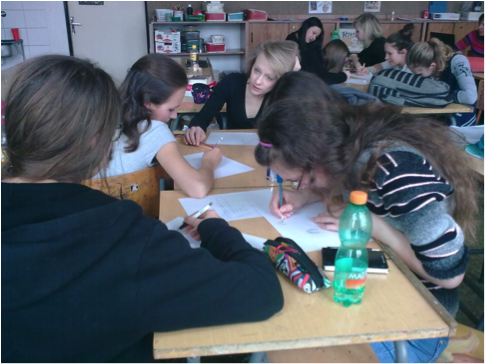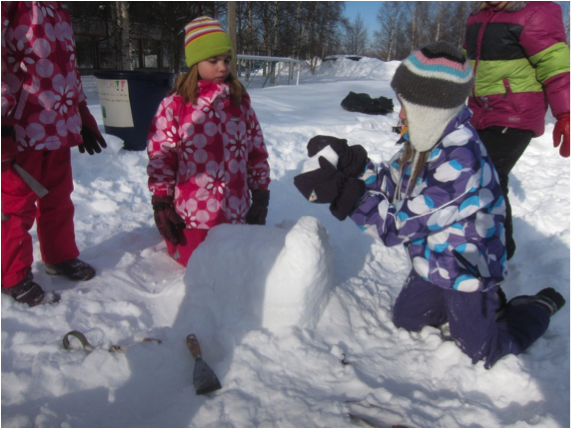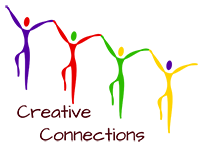Teacher's voice
UK team
A key aim of Creative Connections was to promote and facilitate the voices of children in schools across Europe and to consider ways of cross-European communication which might sustainably support these initial connections. As the project evolved we wanted to ensure that the voices of teachers were heard too. Their input and reflections have been immensely useful in terms of helping us learn about practice; the practical application of the complex communication tools and how we might develop these further within a range of curricula across different European education systems. Analysis of the work in schools and interviews with our teacher-participants has resulted in six core themes: they are presented here and in greater detail on our project website. If you are a teacher, a parent or are interested in education there are fascinating revelations which we hope will inform practice in schools.
1. The freedom of project
Students experienced freedom in all phases of the project: in exploring artworks, in choosing materials and techniques, in choosing to work alone or in group…
(Primary teacher: Portugal).
For many teachers, both primary and secondary, Creative Connections gave them opportunities to work in new and different ways. The exploration of themes and issues appropriate to Europe and being European, through the use of contemporary artworks both challenged them as teachers also provided opportunities for more freedom in their teaching. Emma, a UK secondary art teacher, said that the fact that she was able to “work like an artist” had made her reflect critically on her own practice. Another secondary teacher in the UK felt similarly, “I can invent something for myself in this project, so it's like being an artist again”.
Teachers noted that pupils too found the work liberating, for example a UK primary teacher said that “The children were more free and more creative than in normal art lessons” and enjoyed the cross-curricular aspect of the project. A primary teacher in the Czech Republic claimed that the project was a significant experience for the children; suddenly their work, and even they, became involved with other people´s lives. It became, for some, a process of educational empowerment – something discussed by the Portuguese team. Likewise a Finnish primary school teacher focused on group work to enable pupils to learn “co-operation skills”. The teacher and the pupils enjoyed this different approach and the process of co-operative lesson development (between the teacher & researcher) facilitated further opportunities to share practice and ideas, for example (see image below).

However, such freedom did not always make participation easy. One secondary teacher in the UK felt that the project challenged his pedagogy too much; his approach to the project was student-led and became difficult to manage. His approach championed creativity but also meant that some pupils were “at sea” in having so much freedom in their creative practice. This teacher summed up the project as one of challenge and change; he felt that he had become a facilitator rather than a teacher and this took him out of his usual comfort zone. However, being taken out of his comfort zone meant he used a broader range of materials and sources which had actually enhanced his usual practice.
2. Finding out about pupils
For many teachers, talking about art and exploring identity, whether national or European, meant that they were finding more about their students. A secondary art teacher in the UK enjoyed the chance to find out more about his pupils and their connections to Europe/other countries. He developed a more collaborative approach to working with his pupils, for example he shared the fact that his wife was French and he was a pro-European. However, he was surprised at the level of hostility from pupils in relation to other European nations. In the same vein, one primary UK teacher reflected that she had been able to learn a significant amount about the children in her class and as a result this knowledge impacted on her own ability to create new ideas for art activities. In an Irish secondary school, both teachers felt the value of discussion centred on art work as a means of articulating responses and sharing opinions. Teachers noted that they got to know their pupils better through these discussions.
3. A sense of Europe
The exploration of identity, both national and international, permeated the project in various ways. In one Irish secondary school, teachers dealt with issues of identity (personal, community, national and European) in their classes and explored: stereotyping; use of symbols through mind maps; questioning and discussion. A teacher explained that she had mixed a visual approach with the discursive element:
The whole theme of being European; how to describe that visually for them [ was difficult] so it was all about discussing the different countries and what it meant to be European and it was more wordy and literal in the first instance, rather than visual.
In the same way, the teachers and a resident artist in an Irish primary classroom felt that the Creative Connections project enabled the children to become more aware of the differences and similarities that existed within the classroom. This was established through the exploration and discussion of primary evidence: children presented and responded to costume and artefacts which represented different cultures and customs. However, the resident artist expressed the problematic nature of trying to embed a citizenship concept through an art making process:
I think often what happens when you work with children is that there is a natural process that takes place where things might go a direction that you didn’t anticipate beforehand but it can go that way because it is art. So there is a certain freedom to it but in this case it had to come back to citizenship or it had to come back into identity. That was the theme we wanted the children to work with and I think it felt more constrained than it felt with other projects.
One UK secondary art teacher said that on the whole she felt the pupils’ outlook had been broadened by the project through an awareness of other pupils and people in Europe. By contrast another UK primary teacher voiced concern that the pupils had not engaged deeply with the European aspect, and she thought they had struggled to understand this part largely because of their young age. However, this view was not evident during post project interviews with pupils: researchers found that the pupils were totally engaged in the aims of the projects and raised interesting points about Europe and the EU, saying for example,
“well we learned a lot about the different countries and people I didn’t know there was that many people involved in the EU. I thought there were about 20, but there are absolutely millions of them, and also not just well known countries, but other places. We didn’t really know that those people were out there – like in Czech Republic – you wouldn’t really think that that was part of your own community sort of thing – we didn’t really take any notice of that before”.
In the Czech Republic it appeared that primary aged children engaged successfully with notions of stereotyping, as their teacher explained:
We were talking about marginalized people in general and about Roma, because their ethnicity is very strong in Ústí [a region of the Czech Republic]. I asked children about their opinion, I wanted to know, if they were xenophobic or racist and what did they think about the problems. I was surprised, how easily did children perceive the “strange individuals” around them. I expected them to condemn them, but in fact, the pupils’ opinions were positive. They were interested in “otherness” in this context and enjoyed the topic.

4. Teachers’ initial view of project
Initially, many of the teachers were nervous for a variety of different reasons. Concerns included: the capacity to work creatively; flexibility of approach; expectation of outcomes; freedom required by pupils being able to engage with the concepts; time constraints of the set curriculum; blogging and confidence with digital technology.
For example in Ireland, both secondary teachers’ expectations were initially very positive about the project but they were sceptical that their students had any real perceptions of a European identity. The teachers felt that the age of the pupils might affect their ability to grasp concepts of European citizenship. However, such concerns were unfounded because of the unique way of using art and discussion “… gave the children a way into their own emotions about identity – we absolutely didn’t expect that”.
In one UK primary school, two teachers initially voiced a concern that the pupils would not be able to cope with the project as the concept of European identity would be too complex for them to grasp.
Initially they did not understand what we were talking about but we said, “open yourselves up to it and think about anything you like, anything you think is not wrong, it can’t be wrong’.
To engage the pupils with the notion of identity, they focused on the built environment, with the aim of designing a new European building:
We took them ‘out of the box’ of learning in the classroom…The artwork they produced was fabulous wasn’t it?
Likewise in one Spanish secondary school, the teacher and the pupils encountered several problems when working together. There was resistance from the pupils about exploring their personal identity in relation to Europe, and the pupils found it difficult to understand the project aims. However, through engagement with different artistic activities the pupils managed to generate their own contemporary art that clearly reflected their engagement with project aims.
5. Artwork database
All participants of the project had access to the rich resources of the Creative Connections Artwork Database, and were encouraged to use this as a starting point for their own projects in class. The range of artworks reflected contemporary art from the six partner countries. Children in schools in Portugal used images from the Database as part of the evolution of their classroom projects. In one Finnish primary school teacher used images from the database to analyse and discuss with her class before the pupils created their own soundscapes and snow sculptures. This teacher found the resource particularly influential:
The Artwork Database and the project’s contemporary artworks were used in class more than usual and in different ways. The chosen artworks had connection to the children's everyday lives.
The images from the Artwork Database encouraged pupils and teachers to use talk to explore themes around national and personal identity. As one teacher said:
The use of the database threw up a lot of questions for them and it started them thinking, so in that way that is always a good thing because maybe they hadn’t thought about it before’.
Conclusion
For many of the teachers the Creative Connections project was initially a challenge in many ways: their teaching practice; the linking of art and citizenship; their perceptions of how pupils would engage with European themes. However, by the end of the project, through working on their own projects and using contemporary art, the majority of the teachers were extremely positive about what the pupils had gained from the collaborative and creative nature of the work. The project appears to have encouraged deep reflection on their practice and allowed teachers to gain better understands of their pupils and their lives and identities outside of the school environment.


